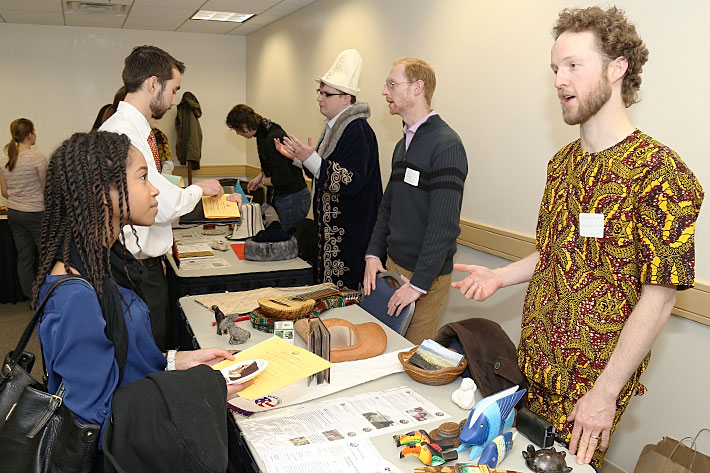For Kristiann Fry, the road to the George Washington University’s Master of Public Health program began in 2009 with service as a Peace Corps volunteer in Kenya. Though she signed up to teach math and science, the bureau’s need for teachers at a school for deaf students shifted her focus.
“It was my first experience doing that kind of work,” Ms. Fry said. “I learned Kenyan sign language, worked with the students and really found that what I liked best was teaching life skills and sexual reproductive health—it led me to public health.”
Ms. Fry’s story—of finding footing in a career path through the Peace Corps—was echoed all during GW Peace Corps Day Tuesday, as return volunteers shared with GW students their stories of service in Togo, Kazakhstan, Zambia and other countries.
The event, organized by the Center for Career Services and Peace Corps recruitment intern and GW senior Tori Jackson, offered an orientation for students on the application process, building a resume and preparing for the interview.
GW was named a top Peace Corps volunteer-producer in February, coming in at No. 3 among medium-sized schools.
“We planned this event to encourage students to learn more about the Peace Corps,” Ms. Jackson said. “As an intern, student and prospective applicant, I can say that speaking with return volunteers has helped me gain new information.”
Peace Corps Day kicked off with a “Peace Car” showing at Mount Vernon Campus. The smart car is one of five sent from Peace Corps headquarters in October to travel the country and share the message of the organization.
#GWU talk to @PeaceCorps volunteers #PeaceCars @GWmvc until noon pic.twitter.com/j0BXawAc2V
— GW Career Services (@gwcareercenter) March 3, 2015In the afternoon, students learned about the new shortened application process. The new application takes two hours to complete—down from eight hours—and allows students to apply directly to postings in specific countries. The Peace Corps also introduced a new placement policy in July, which lets students indicate their location preference for service.
Africa and Latin America top the list of most popular places to serve with 45 percent and 23 percent of volunteers respectively, according to Peace Corps data released in 2014.
Taylor Rose, Peace Corps volunteer placement and assessment specialist, said that since the new policy took effect, the Peace Corps has had a 22-year record high in application submissions.
“The ability to choose has attracted people to the program who are passionate about service and really want to take charge of their career path,” said Ms. Rose, who served from 2011 to 2013. “But many still choose to be assigned a destination. I never would have chosen Indonesia, but it was a perfect fit.”
Elliott School of International Affairs junior Adrian Evans attended the event because—like the 1,161 GW alumni who have served in the Peace Corps to date—he is inspired by global service.
“Today, I’ve been able to see how personal the experience is, how when you are serving others, you are really learning about yourself,” Mr. Evans said.
As for where he sees a future career? He said that’s the “million dollar question.”
“I’m not sure just yet,” Mr. Evans said. “But the Peace Corps could help me figure it out.”


